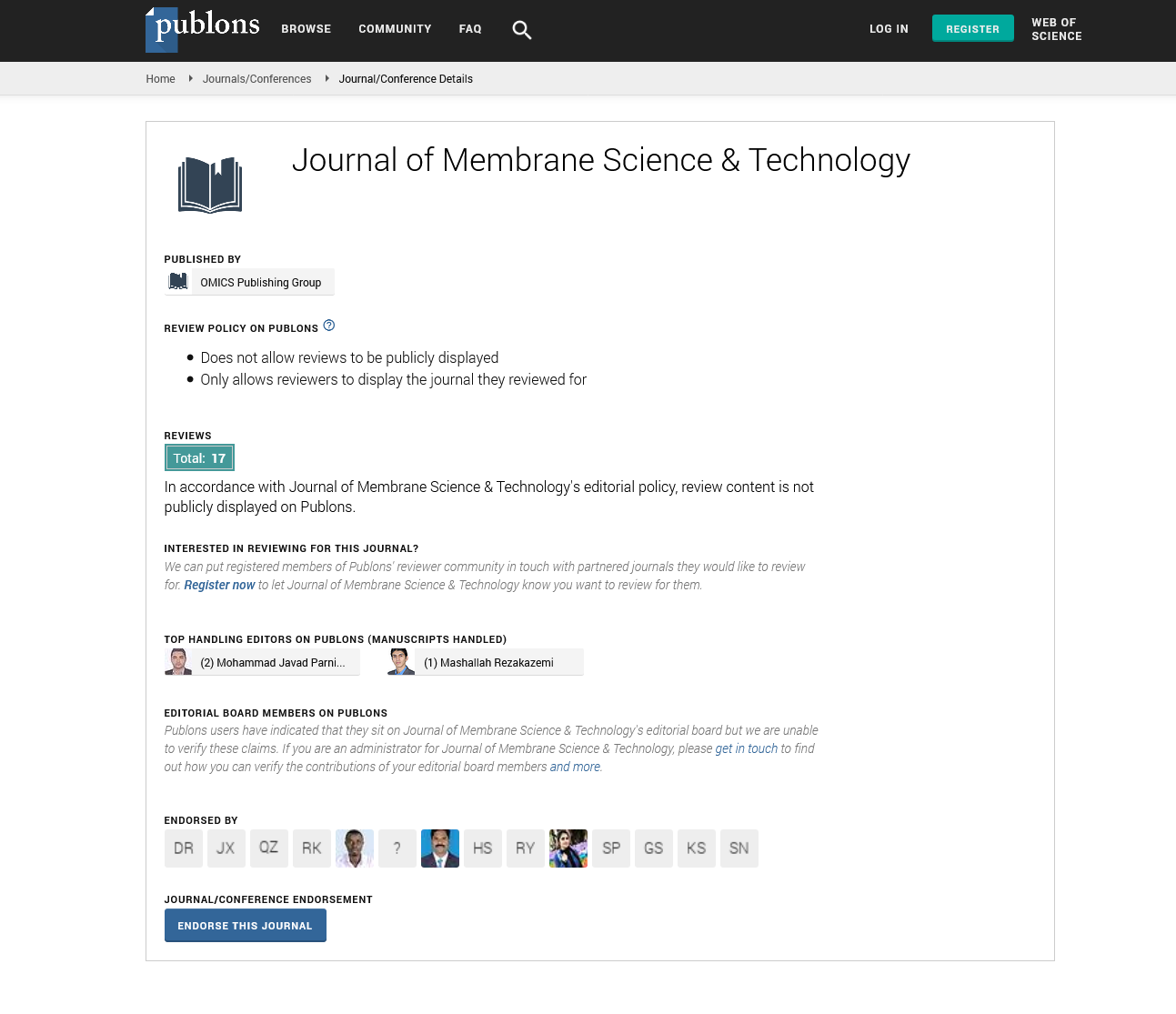Indexed In
- Open J Gate
- Genamics JournalSeek
- Ulrich's Periodicals Directory
- RefSeek
- Directory of Research Journal Indexing (DRJI)
- Hamdard University
- EBSCO A-Z
- OCLC- WorldCat
- Proquest Summons
- Scholarsteer
- Publons
- Geneva Foundation for Medical Education and Research
- Euro Pub
- Google Scholar
Useful Links
Share This Page
Journal Flyer

Open Access Journals
- Agri and Aquaculture
- Biochemistry
- Bioinformatics & Systems Biology
- Business & Management
- Chemistry
- Clinical Sciences
- Engineering
- Food & Nutrition
- General Science
- Genetics & Molecular Biology
- Immunology & Microbiology
- Medical Sciences
- Neuroscience & Psychology
- Nursing & Health Care
- Pharmaceutical Sciences
Short Communication - (2024) Volume 14, Issue 2
Insights into Cellular Communication: Fluorescence Microscopy of Membrane Protein Interactions
Mateusz Ozdemir*Received: 20-May-2024, Manuscript No. JMST-24-26208; Editor assigned: 22-May-2024, Pre QC No. JMST-24-26208 (PQ); Reviewed: 05-Jun-2024, QC No. JMST-24-26208; Revised: 12-Jun-2024, Manuscript No. JMST-24-26208 (R); Published: 19-Jun-2024, DOI: 10.35248/2155-9589.24.14.393
Description
Investigations of membrane protein interactions in cells using fluorescence microscopy offer a fascinating glimpse into the dynamic and complex field of cellular biology. Membrane proteins play vital roles in various cellular functions, including signal transduction, molecular transport, and cell-cell communication. Understanding how these proteins interact within the complex environment of the cell membrane is essential for translating fundamental biological processes and developing targeted therapeutic strategies.
Fluorescence microscopy has revolutionized the study of membrane protein interactions by providing researchers with powerful tools to visualize and analyze these interactions in real time. Unlike conventional microscopy techniques, fluorescence microscopy utilizes fluorescent probes or tags that specifically bind to target proteins, allowing researchers to track their movements and interactions with high accuracy [1]. One of the key advantages of fluorescence microscopy is its ability to visualize proteins in their native cellular environment without the need for invasive techniques that might disrupt cellular structures or functions. By labeling membrane proteins with fluorescent tags, researchers can observe how these proteins behave under various conditions, such as during cell signaling events or in response to external stimuli [2].
The process typically begins with the selection of a suitable fluorescent tag that can bind to the target membrane protein without interfering with its function or localization within the cell membrane. Green Fluorescent Protein (GFP) and its derivatives are commonly used due to their brightness, stability, and compatibility with living cells. These tags are genetically encoded, allowing researchers to express them in cells of interest and study the dynamics of membrane protein interactions in real time [3-6]. Once labeled, the cells are observed using a fluorescence microscope equipped with appropriate filters and detectors to capture emitted light from the fluorescent tags. Advanced microscopy techniques, such as confocal microscopy and super-resolution microscopy, further enhance the spatial resolution and clarity of images, enabling researchers to determine individual protein complexes and their interactions within the crowded environment of the cell membrane [7].
Quantitative analysis of fluorescence microscopy data provides valuable insights into the stoichiometry, dynamics, and spatial organization of membrane protein interactions. Techniques like Fluorescence Resonance Energy Transfer (FRET) can be employed to measure distances between interacting proteins at the nanometer scale, offering clues about the conformational changes and binding affinities that underlie these interactions. Moreover, fluorescence microscopy allows researchers to study how membrane protein interactions are regulated in response to physiological cues or disease states. For instance, aberrant interactions between membrane proteins have been implicated in various diseases, including cancer and neurodegenerative disorders. By elucidating the molecular mechanisms underlying these interactions, researchers can identify potential targets for therapeutic intervention [8,9].
Recent advancements in fluorescence microscopy have expanded its capabilities beyond static imaging to include dynamic studies of membrane protein interactions in living cells. Fluorescence Recovery After Photobleaching (FRAP) and Fluorescence Correlation Spectroscopy (FCS) are techniques commonly used to study protein diffusion rates, mobility within the membrane, and the dynamics of protein-protein interactions over time. The integration of fluorescence microscopy with computational modeling and bioinformatics tools further enhances our ability to analyze complex datasets and derive meaningful insights into membrane protein interactions. Computational approaches can predict potential interaction partners, map interaction networks, and simulate the effects of mutations or drug treatments on protein interactions, thereby guiding experimental design and hypothesis testing. Despite its numerous advantages, fluorescence microscopy also faces challenges, such as photo bleaching of fluorescent tags, photo toxicity to living cells, and the potential for artifacts due to overexpression of tagged proteins. Addressing these limitations requires careful experimental design, optimization of imaging conditions, and validation of findings using complementary techniques, such as biochemical assays and electron microscopy [10].
In conclusion, fluorescence microscopy has revolutionized our ability to investigate membrane protein interactions in living cells, offering unprecedented insights into the dynamic and spatial organization of these interactions. By combining advanced imaging techniques with computational analysis, researchers can explain the complexities of membrane biology and providing insights for novel approaches in both basic and clinical research. Ultimately, these insights may lead to novel therapeutic strategies targeting membrane proteins implicated in human diseases, thereby advancing our understanding of cellular function and physiology.
References
- Yin H, Flynn AD. Drugging membrane protein interactions. Annu Rev Biomed Eng. 2016;18(1):51-76.
[Crossref] [Google Scholar] [PubMed]
- Cho W, Stahelin RV. Membrane-protein interactions in cell signaling and membrane trafficking. Annu Rev Biophys Biomol Struct. 2005;34(1):119-151.
[Crossref] [Google Scholar] [PubMed]
- Lee AG. Lipid–protein interactions in biological membranes: A structural perspective. Biochim Biophys Acta. 2003;1612(1):1-40.
[Crossref] [Google Scholar] [PubMed]
- Liu Q, Zheng J, Sun W, Huo Y, Zhang L, Hao P, et al. A proximity-tagging system to identify membrane protein-protein interactions. Nat Methods. 2018;15(9):715-722.
[Crossref] [Google Scholar] [PubMed]
- Dowhan W, Bogdanov M. Lipid-protein interactions as determinants of membrane protein structure and function. 2011;39(3):767-774
[Crossref] [Google Scholar] [PubMed]
- Moore DT, Berger BW, DeGrado WF. Protein-protein interactions in the membrane: sequence, structural, and biological motifs. Structure. 2008;16(7):991-1001.
[Crossref] [Google Scholar] [PubMed]
- Muller MP, Jiang T, Sun C, Lihan M, Pant S, Mahinthichaichan P, et al. Characterization of lipid-protein interactions and lipid-mediated modulation of membrane protein function through molecular simulation. Chem Rev. 2019;119(9):6086-6161.
[Crossref] [Google Scholar] [PubMed]
- Miller JP, Lo RS, Ben-Hur A, Desmarais C, Stagljar I, Noble WS, et al. Large-scale identification of yeast integral membrane protein interactions. Proc Natl Acad Sci USA. 2005;102(34):12123-12128.
[Crossref] [Google Scholar] [PubMed]
- Corradi V, Mendez-Villuendas E, Ingólfsson HI, Gu RX, Siuda I, Melo MN, et al. Lipid–protein interactions are unique fingerprints for membrane proteins. ACS Cent Sci. 2018;4(6):709-717.
[Crossref] [Google Scholar] [PubMed]
- Wiggins P, Phillips R. Membrane-protein interactions in mechanosensitive channels. Biophys J. 2005;88(2):880-902.
[Crossref] [Google Scholar] [PubMed]
Citation: Ozdemir M (2024) Insights into Cellular Communication: Fluorescence Microscopy of Membrane Protein Interactions. J Membr Sci Technol. 14:393.
Copyright: © 2024 Ozdemir M. This is an open-access article distributed under the terms of the Creative Commons Attribution License, which permits unrestricted use, distribution, and reproduction in any medium, provided the original author and source are credited.

